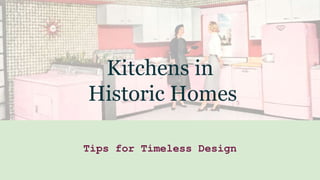Kitchens in historic homes
- 1. Kitchens in Historic Homes Tips for Timeless Design
- 2. Old Kitchens / Not So Old Kitchens
- 3. Layout
- 10. Cabinets
- 12. Age of Sanitation Changing WomenŌĆÖs Roles
- 13. Post WWI Door & Drawer Styles
- 20. Plate Racks
- 22. Moveable Pieces
- 23. Breakfast Nooks
- 24. Hardware
- 25. Counter Tops
- 26. Wood
- 27. Tile
- 31. Back Splashes
- 32. Tile Wood
- 33. Sinks
- 35. Appliances
- 36. Antique/ Replica
- 37. Hidden
- 39. Floors
- 40. Wood
- 41. Linoleum
- 42. Tile
- 43. Lighting
- 45. Sample Kitchen
Editor's Notes
- #3: Changes to technology over the years Cooking Methods Staff Equipment Kitchens Expensive Design Fads/ Dated Poor Layouts Small Size Damage/ Rot/ Dirt
- #6: No leg of the triangle should be less than 4 feet or more than 9 feet The sum of all three sides of the triangle should be between 13 feet and 26 feet If possible, there should be no major traffic flow through the triangle
- #7: Purist: Not suited to modern life Modern: Not in keeping with house style/ feel
- #12: Raised Panel Stained and painted Base on higher end homes
- #13: Women vote Icebox common by 1930s Toaster and other appliances Discovery of germs Looks like furniture pieces
- #14: Run uppers to ceiling 1890s germs and viruses known Flat panel or beadboard
- #15: Run uppers to ceiling
- #16: Paint toe kick black
- #17: 1930/40s Ice box Color Plywood
- #18: Metal or wood (plywood) 1950s
- #19: Uppers reach to the ceiling Until the 1930s
- #20: Up to 1920s
- #22: Hoosier Cabinet Furniture
- #26: Soapstone Tile Marble Wood Linoleum
- #30: Monel (copper, nickle alloy) in 20s and 30s Stainless in the 50s
- #31: Metal edge
- #32: Tile Wood Plaster
- #33: Plaster
- #42: Rugs Checkered
- #44: Schoolhouse pendants
- #45: Older lights bare bulbs No hats Over work space
- #50: Staged by Real estate agent




















































